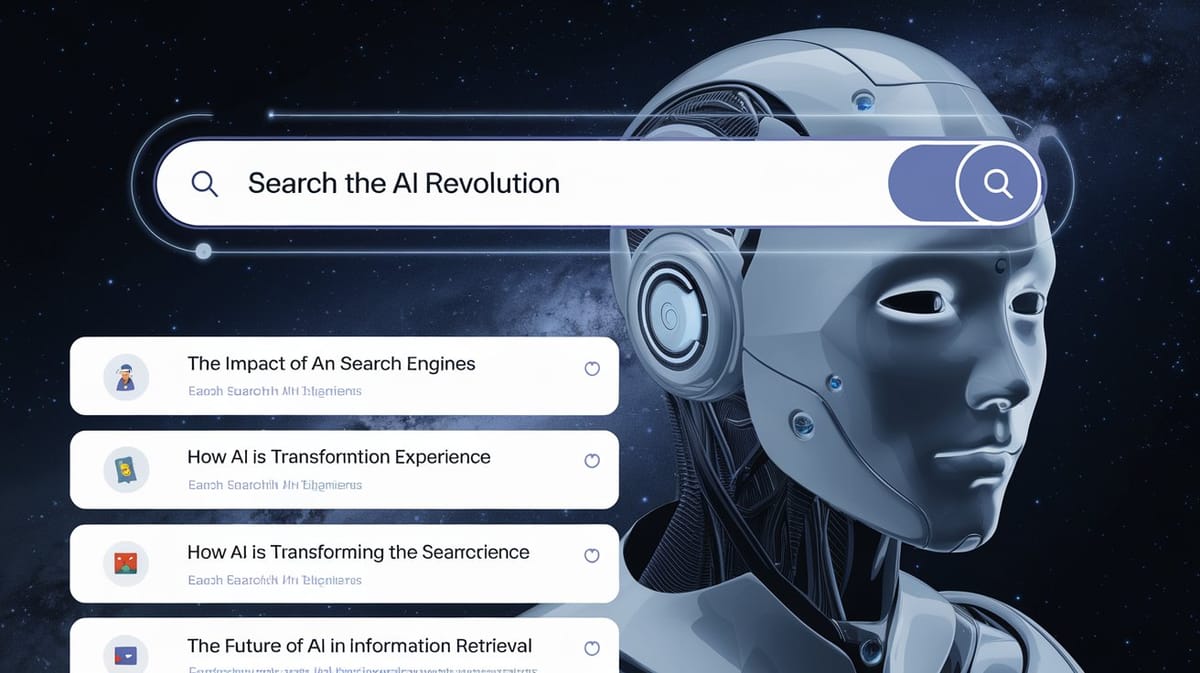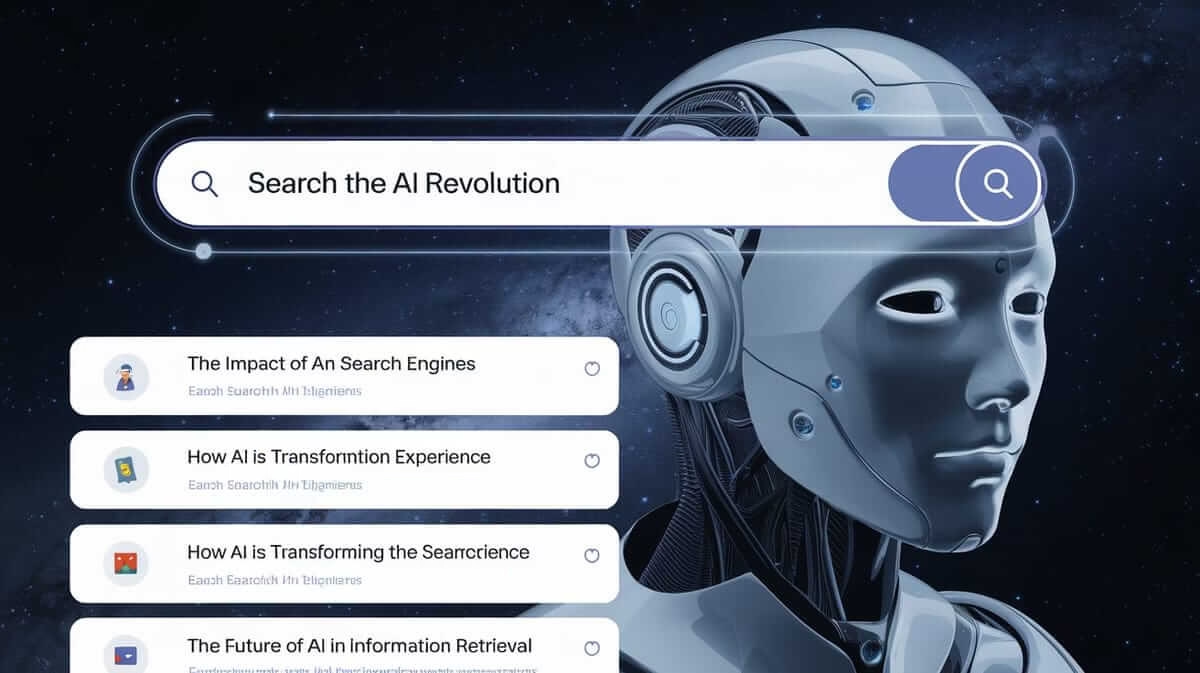Revolutionary AI Search Technology: Transforming How We Find Information
Estimated reading time: 8 minutes
Key Takeaways
- Revolutionary AI search technology leverages machine learning (ML), natural language processing (NLP), and real-time data to understand user intent and deliver precise, personalized answers.
- Unlike traditional keyword-based search, AI employs semantic search to grasp context, synonyms, and complex queries, offering more relevant results.
- Key components like bi-encoders and cross-encoders help AI process queries, convert text to vectors, and rank results based on relevance.
- AI personalized web browsing tailors search results based on user history, location, and preferences, creating a more intuitive experience but raising privacy concerns.
- Voice search AI is becoming increasingly sophisticated, understanding natural language, accents, and multiple languages, enabling hands-free information access.
- AI significantly impacts search engine algorithms by improving ranking, detecting spam, and aiming for bias mitigation, though challenges like filter bubbles remain.
- Future trends include Augmented Reality (AR) search, emotion-aware AI, and decentralized, privacy-focused search engines.
Table of Contents
- Introduction to AI-Driven Search Evolution
- Understanding AI-Powered Search Engines
- How Revolutionary AI Search Technology Works
- Personalization in Modern Search: AI-Powered Web Browsing
- Voice Search AI: Bridging Conversational Gaps
- The Impact of AI on Search Engine Algorithms
- Future Trends in AI-Driven Search Technology
- Frequently Asked Questions

1. Introduction to AI-Driven Search Evolution
Revolutionary AI search technology is fundamentally reshaping how we interact with information online. Gone are the days of meticulously typing rigid keywords into a search bar and sifting through pages upon pages of marginally relevant results. Today, sophisticated AI-driven systems are emerging, capable of delivering answers with breathtaking speed, profound contextual understanding, and hyper-personalized outcomes that feel almost clairvoyant.

Traditional search engines primarily relied on basic techniques like keyword matching and the quantity and quality of backlinks to rank web content. Now, advanced tools such as Google’s AI-powered search, incorporating models like BERT (Bidirectional Encoder Representations from Transformers), and OpenAI’s innovations like GPT (Generative Pre-trained Transformer) utilize complex natural language processing (NLP). This allows them to interpret the nuances of human language, predict the underlying intent behind a query, and generate dynamic, synthesized results rather than just a list of links.
For instance, asking a practical question like, “What’s the best way to fix a leaky faucet?” no longer yields a simple, static list of plumbing blogs or hardware store websites. Instead, modern AI search can synthesize information from multiple sources, potentially providing a concise summary of step-by-step instructions, embedding relevant tutorial videos, and even surfacing contact information for reputable local repair services – all within seconds.
This evolution isn’t merely about increased speed—it represents a significant leap in intelligence. AI diligently analyzes patterns in user behavior, considers contextual factors like geographic location, and can even factor in the time of day to tailor responses more effectively. The ultimate outcome? A seamless, intuitive search experience that feels remarkably conversational, almost like interacting with a knowledgeable human assistant. Sources confirm how this technology is fundamentally redefining the landscape of information discovery.
2. Understanding AI-Powered Search Engines
AI-powered search engines represent a paradigm shift, built upon three technological pillars working in concert:
- Machine learning (ML): Sophisticated algorithms continuously learn and refine their performance by analyzing vast datasets of queries, user interactions, and web content, improving accuracy and relevance over time without explicit programming for every scenario.
- Natural language processing (NLP): This enables the systems to truly understand human language, including colloquialisms, slang, typos, complex sentence structures, and the implicit meaning behind questions.
- Real-time data analysis: Search results aren’t static; they update almost instantly to reflect the latest information, news breaks, trending topics, and changes in the real world.

Let’s contrast this with traditional search engine algorithms. Historically, these ranked pages largely based on keyword density (how often keywords appear) and the authority signaled by inbound links. For example, searching for “healthy dinner ideas” might have prioritized websites that simply repeated the exact phrase “healthy dinner” multiple times. AI fundamentally changes this game. Platforms like Perplexity AI utilize semantic search, focusing on the meaning and intent behind the query rather than just the words themselves.

If you ask, “What’s a quick meal involving chicken and spinach?” the AI identifies “quick” as a crucial constraint (time sensitivity) and “chicken and spinach” as key ingredients, then intelligently fetches recipes that match this specific contextual need. Google’s BERT model exemplifies this advancement by analyzing entire sentences and the relationship between words, not just isolated keywords. This contextual understanding allows it to handle complex conversational queries and even follow-up questions, such as asking “How many calories does that recipe have?” without needing the user to repeat the context from the previous search. Insightful articles from sources like Antematter on agentic search and Cameron R. Wolfe on vector search explain how underlying technologies like vector embeddings and neural networks power these remarkable advancements, turning language into mathematical representations that AI can process effectively.
Furthermore, AI tools are increasingly integrated into broader productivity suites. For example, the development and release of tools like Microsoft Copilot, which recently debuted an Android app, showcase how AI-driven search capabilities are merging with everyday workflows, aiming to redefine productivity by providing contextual information and assistance directly within applications.
3. How Revolutionary AI Search Technology Works
At its core, Revolutionary AI search technology relies heavily on advanced artificial neural networks, complex systems modeled loosely on the human brain, to process and understand queries. The process often involves sophisticated techniques like:
- Bi-encoders: These are crucial for efficiency. They independently convert both the user’s query and potential documents (web pages, articles, etc.) into numerical representations called vectors or embeddings. Think of these vectors as unique “meaning fingerprints.” The system can then quickly find documents whose fingerprints are mathematically similar to the query’s fingerprint, indicating semantic relevance. This pre-computation allows for rapid initial filtering of vast amounts of information.
- Cross-encoders: Once a smaller set of potentially relevant documents is identified using bi-encoders, cross-encoders come into play. They take the query and a candidate document *together* as input and perform a more detailed, computationally intensive analysis to precisely score the relevance of that specific document to the query. This second pass ensures that the final results presented to the user are ranked accurately, with the best answers appearing first.
Let’s illustrate with an example. Suppose you search for “best budget phone under $300 with good camera.” The AI search engine initiates a multi-step process:
- Query Parsing and Understanding: The AI uses NLP to break down the query. It recognises “best” implies a need for high quality or top ranking, “budget” is synonymous with “affordable” or “low-cost,” “phone” means “smartphone,” “$300” sets a specific price constraint, and “good camera” highlights a key feature requirement.
- Vector Representation (Bi-encoding): The query is converted into a numerical vector representing its core meaning. Simultaneously, vectors for millions of web pages (reviews, product pages, forum discussions, articles) have likely already been pre-computed and stored in a searchable index.
- Candidate Retrieval: The system efficiently searches the vector index for documents whose vectors are closest (most similar) to the query vector, focusing on content discussing smartphones, pricing under $300, and camera quality.
- Re-ranking (Cross-encoding): The top candidate documents are then passed through cross-encoders along with the original query. This stage meticulously evaluates how well each document satisfies *all* aspects of the query – price, camera quality, overall value (“best”). It might prioritize recent reviews over older ones or user forum discussions over manufacturer marketing pages.
- Result Synthesis and Presentation: Finally, the AI might not just present links. It could synthesize key information, perhaps generating a comparison table of the top 3 phones meeting the criteria, extracting key specs (like megapixels, battery life), summarizing user review sentiment, and providing direct links to purchase or read full reviews.
This sophisticated process explains why AI search often feels more helpful than traditional methods. A traditional engine might prioritize a blog post titled “10 Best Budget Phones of 2023” simply because it contains the keywords, even if the content is generic or doesn’t specifically address the camera quality under $300. AI aims to bypass the fluff and deliver direct, actionable answers. Detailed explanations from sources like Perplexity AI comparing AI vs. traditional search and Cameron R. Wolfe on vector search mechanics further illuminate how this semantic approach consistently outperforms older keyword-based models, especially for complex or nuanced queries.
The integration of AI isn’t limited to just web search. It’s transforming interactions across various digital platforms. For instance, the evolution described in the Future of AI chatbots in Customer Service: Revolutionary AI Chatbots article shows how similar NLP and machine learning techniques are enabling more natural, helpful, and efficient conversations in customer support contexts, mirroring the advancements seen in search.
4. Personalization in Modern Search: AI-Powered Web Browsing
AI personalized web browsing signifies a fundamental shift where your search engine actively learns and adapts specifically to *you*. It moves beyond one-size-fits-all results by remembering your past queries, considering your geographical location, understanding your inferred interests, and analyzing your interaction patterns to deliver search results that feel uniquely tailor-made.
Imagine you’re planning a vacation to Paris. Your search journey might unfold like this:
- Initial search: “Best boutique hotels near the Eiffel Tower.”
- Next related query: “Cheapest direct flights from NYC to CDG in September.”
- Follow-up question: “Typical weather in Paris early autumn.”
- Later search: “Museum pass Paris cost effective?”

A sophisticated AI-powered search engine doesn’t treat these as isolated events. It connects the dots, inferring that you are actively organizing a budget-conscious trip to Paris for the upcoming autumn season, with interests in specific landmarks and cultural attractions. Consequently, future related searches might automatically prioritize information relevant to this context. It might proactively surface flight deals matching your origin and dates, highlight affordable hotels near your preferred location, recommend budget-friendly restaurants, provide packing tips based on the anticipated weather forecast, and perhaps even suggest relevant travel articles about navigating Paris cost-effectively. Google’s AI ecosystem already implements versions of this by subtly leveraging user activity data across linked services like Gmail, Maps, and Chrome to personalize experiences, including search results. As noted by sources like CTI Digital, this level of personalization aims to reduce “search fatigue”—the frustration of repeatedly refining queries—and ultimately keep users more engaged by anticipating their needs.
This trend of hyper-personalization driven by AI isn’t confined to web search. It’s increasingly prevalent in other technology domains. Consider the integration of AI in Smart Home Devices, where systems learn your routines to automate lighting, temperature, and security. Similarly, upcoming operating system enhancements, like the previewed Apple Intelligence features in iOS 18, promise deeper personalization by leveraging on-device AI to understand user context across different apps and interactions, offering proactive suggestions and customized assistance.
5. Voice Search AI: Bridging Conversational Gaps
Voice search AI represents a major leap towards more natural human-computer interaction, allowing users to speak conversationally to devices like Amazon Alexa, Google Assistant, or Apple’s Siri. Instead of needing to formulate precise, typed keywords like “weather New York today,” you can simply ask naturally, “Hey Google, will I need an umbrella in Brooklyn this afternoon?” The AI is designed to understand the intent and context within that conversational phrasing.
Several key technological innovations underpin the growing capabilities of modern voice search:
- Advanced Speech Recognition: Modern systems use deep learning models trained on vast amounts of speech data to accurately transcribe spoken words into text, even in noisy environments.
- Accent Adaptation: AI algorithms are increasingly adept at understanding a wide array of accents, dialects, and regional speech patterns, moving beyond standard pronunciations. This involves sophisticated acoustic modeling that adapts to individual users over time.
- Improved Natural Language Understanding (NLU): Beyond just recognizing words, the AI must grasp the meaning, intent, and entities within the spoken request (e.g., identifying “Brooklyn” as a location and “umbrella” as related to rain).
- Multilingual Support: Many voice assistants can now understand and respond in multiple languages, sometimes even detecting and switching languages automatically within a single interaction (code-switching), catering to bilingual users.
- Contextual Awareness: Like text-based AI search, voice AI can often maintain context across multiple turns in a conversation. You might ask “Who directed The Godfather?” and follow up with “How old was he when he made it?” without repeating the movie title.
- Effective Noise Cancellation: Advanced signal processing techniques help filter out background sounds (traffic, music, other conversations), allowing the AI to focus on the user’s voice command, which is crucial for real-world usability, especially on mobile devices or smart speakers.

Despite significant progress, challenges remain. Accents from non-native speakers, rapid or mumbled speech, unusual slang, or highly specific jargon can still confuse some systems, leading to transcription errors or misunderstandings. However, cutting-edge transcription models, like OpenAI’s Whisper, demonstrate remarkable robustness in handling diverse and challenging audio inputs.
Voice search particularly excels in hands-free scenarios, transforming how we access information while engaged in other activities. Common use cases include:
– Cooking: “Alexa, set a timer for 15 minutes.” or “How many tablespoons are in a quarter cup?”
– Driving: “Siri, find the nearest gas stations along Route 66.” or “Navigate home.”
– Accessibility: Providing a crucial interface for users with visual impairments or physical disabilities.
– Smart Home Control: “Okay Google, dim the living room lights.”
Furthermore, as highlighted by publications like Business Insider Africa discussing the search revolution, advancements in real-time translation integrated with voice AI are actively breaking down language barriers. You can ask your device, “How do you say ‘thank you very much’ in Mandarin Chinese?” and the AI can respond not only with the correct phrase (非常感谢 – Fēicháng gǎnxiè) but often also with an audio pronunciation guide, making cross-cultural communication slightly easier.
6. The Impact of AI on Search Engine Algorithms
The integration of Artificial Intelligence has fundamentally transformed search engine algorithms, moving them far beyond their origins as simple keyword counters and link analyzers. AI now permeates nearly every aspect of how search engines discover, understand, rank, and present information. Here’s how AI enhances them:
- Improved Ranking Factors – Focus on Intent: AI-powered Natural Language Processing allows search engines to understand the intent and context behind a query, not just the literal keywords used. This means contextual relevance and the quality of information often outweigh traditional factors like keyword density or sheer backlink volume. For example, a comprehensive, well-explained page about “DIY plumbing fixes for beginners” might rank higher for a query like “how to stop a running toilet” than a generic hardware store category page, even if the latter has more backlinks, because it better matches the likely user intent.
- Enhanced Content Understanding: AI models can analyze the content of a page more deeply, understanding topics, identifying entities (people, places, things), assessing sentiment, and even evaluating the structure and readability of the text and visual elements. This allows for more nuanced relevance judgments.
- Sophisticated Spam Detection: Machine learning algorithms are exceptionally effective at identifying patterns indicative of low-quality or manipulative content (spam). They can detect techniques like keyword stuffing, cloaking (showing different content to search engines than to users), automatically generated content, and link schemes far more effectively than manual rules-based systems.
- Bias Mitigation Efforts: Recognizing that AI models can inherit biases present in their training data, search companies are actively working on techniques to promote fairness and mitigate algorithmic bias. This involves using more diverse datasets, developing fairness metrics, and implementing algorithmic adjustments to avoid unduly favoring or disadvantaging certain demographics, viewpoints, or types of content.
- Personalization (as discussed earlier): AI enables the tailoring of search results based on individual user history, location, and preferences, aiming to make results more relevant to each person.

However, the increasing role of AI in search also brings significant ethical considerations and challenges. The very personalization that makes search feel intuitive can lead to the creation of “filter bubbles” or “echo chambers,” where users are predominantly exposed to content that confirms their existing beliefs, potentially limiting exposure to diverse perspectives. Additionally, the tracking of user behavior required for deep personalization raises substantial privacy concerns. While companies like Google offer features such as “Incognito Mode” or controls over data retention, ongoing debates about data ownership, transparency in algorithmic decision-making, and the potential for misuse of personal information persist. For deeper insights into the comparison between AI and traditional search ethics and functionalities, refer to Perplexity AI’s analysis and perspectives offered by Business Insider Africa on the broader transformation.
7. Future Trends in AI-Driven Search Technology
The evolution of search is far from over. The next wave of revolutionary AI search technology promises even more integrated, intuitive, and powerful ways to access and interact with information. Some key emerging trends include:
-
- Augmented Reality (AR) Search: Imagine pointing your smartphone camera at a building and instantly seeing relevant information overlaid—tenant names, historical facts, or available apartments. Point it at a plant, and an AI identifies the species and provides care instructions. Point it at a restaurant, and AR could display user reviews, menu highlights, daily specials, and even hygiene ratings floating next to the entrance. Companies are actively developing AR glasses and integrating AR features into mobile apps. As futurists at platforms like Rocket Farm Studios predict, AR search aims to seamlessly merge the physical and digital worlds, making information contextually available based on what you see around you.
- Multimodal Search: Future search engines will increasingly accept multiple input types simultaneously. You might upload a photo of a chair, type “find similar styles under $500,” and speak the color “in blue.” The AI would need to process image data, text constraints, and voice commands together to fulfill the request. This allows for more complex and natural queries that reflect how humans gather information using multiple senses.
- Predictive and Proactive Search: AI could anticipate your information needs before you even explicitly search. Based on your calendar, location, time of day, and past behavior, your device might proactively surface traffic information for your commute, suggest relevant news articles related to your interests, or remind you to buy groceries based on a recipe you viewed earlier. This shifts search from a reactive tool to a proactive assistant.
- Emotion-Aware AI: While ethically complex, research is exploring AI that can infer user emotional states (e.g., from text sentiment, voice tone, or even biometric data) and potentially adjust results accordingly. For example, if the AI detects signs of stress, it might prioritize calming resources like meditation guides, relaxing music playlists, or mental health support information. Conversely, detecting excitement about a topic might yield more in-depth, enthusiast-level content.

- Hyper-Personalization 2.0: Going beyond simple history and location, future AI might build a deeply nuanced understanding of individual knowledge gaps, learning styles, and long-term goals. Search results could be tailored not just to what you want to know, but how you learn best, potentially offering explanations at different levels of complexity or in different formats (text, video, interactive simulation).
- Decentralized Search Engines: Driven by privacy concerns surrounding centralized tech giants, blockchain-based search engines like Presearch are emerging. These aim to distribute search operations across a network of user-operated nodes. Users might earn cryptocurrency tokens for contributing resources or using the search engine. This model offers the potential for greater user control over data, censorship resistance, and a more community-driven approach to search, providing a fundamental alternative to the current ad-driven, data-tracking models of companies like Google.
These compelling future trends underscore AI’s trajectory towards creating search experiences that are not only faster and more accurate but also more immersive, context-aware, empathetic, and potentially more secure and user-controlled. For a broader perspective on how artificial intelligence is reshaping various aspects of our lives and work, exploring resources like this list of 10 Cutting Edge AI Technologies Shaping the Future can provide valuable context on the wider technological landscape influencing search and beyond.

Frequently Asked Questions
1. What is the main difference between AI search and traditional search?
The main difference lies in understanding intent versus matching keywords. Traditional search engines (like early Google) primarily matched the words in your query to words on web pages and ranked based on factors like keyword frequency and backlinks. AI search uses Natural Language Processing (NLP) and Machine Learning (ML) to understand the meaning, context, and intent behind your query, even if you use synonyms, complex sentences, or conversational language. This semantic understanding allows AI to provide more relevant, direct answers rather than just a list of links containing keywords.
2. How does AI personalize search results?
AI personalizes search results by learning from your behavior and context. It analyzes factors like your past search history, click patterns (which results you engage with), geographical location, the time of day, device type, and potentially data from linked accounts (like Google Maps or Gmail activity, if permissions are granted). By building a profile of your interests and needs, the AI tailors the ranking and presentation of results to be more relevant specifically to you. For example, a search for “best pizza” will likely prioritize different restaurants for a user in Chicago versus one in Naples.
3. Is AI search better than traditional search?
In many ways, yes. AI search generally provides more relevant results for complex, conversational, or nuanced queries due to its deeper understanding of language and intent. It can synthesize information, answer questions directly, and handle voice commands more effectively. However, “better” can be subjective. Some users might prefer the simpler, less personalized list of links from older search methods, especially if they have privacy concerns about behavioral tracking used for personalization or worries about filter bubbles narrowing their perspective.
4. What are the privacy concerns with AI search technology?
The primary privacy concern stems from the data collection required for personalization. To tailor results effectively, AI search engines often track user queries, browsing history, location data, clicks, and potentially other interactions across related services. This raises questions about:
– What specific data is being collected?
– How securely is it stored?
– Who has access to it?
– Is it being used for purposes beyond improving search results (e.g., targeted advertising)?
– How transparent and controllable is this data collection?
While companies offer privacy controls and anonymization techniques, the potential for data breaches or misuse remains a significant concern for many users.

5. How does voice search AI understand different accents and languages?
Voice search AI relies on sophisticated ML models, particularly deep neural networks, trained on massive datasets containing speech from diverse populations. These models learn to identify phonetic patterns associated with different accents, dialects, and languages. Techniques include:
– Acoustic Modeling: Learning the relationship between audio signals and phonetic units.
– Language Modeling: Understanding the probability of word sequences in a given language.
– Speaker Adaptation: Algorithms can sometimes fine-tune themselves to a specific user’s voice and accent over time.
– Large Training Data: Exposure to vast amounts of varied speech data during training is crucial for robustness against variations in pronunciation and language.
Continuous improvement in these areas allows voice assistants to become increasingly accurate across different linguistic backgrounds.






